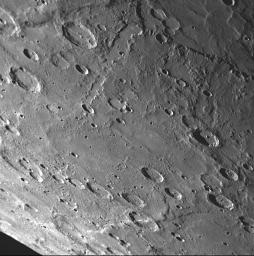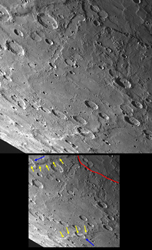
|
The Rim of Rembrandt and Neighboring Scarps
- Click the image above for a larger view
- Full-Res JPEG (1018 x 1026) (195.9 kB)
- Full-Res TIFF (1018 x 1026) (1.0 MB)
Caption:

Click on the image for larger version
The large Rembrandt impact basin was discovered during MESSENGER's second Mercury flyby. A portion of the rim of that basin (outlined in red) is visible at top right in this high-resolution NAC image returned from the mission's recent third Mercury encounter. Two scarps (cliffs) can also be identified in this image (yellow arrows); both scarps cut across craters that have been deformed by the faulting that produced the scarps (blue arrows). Because this area of Mercury's surface was imaged during both MESSENGER's second and third Mercury flybys, there is now stereo coverage that enables a three-dimensional visualization of the surface to be constructed. Information about the surface topography is valuable for MESSENGER scientists working to decipher the geological history of Rembrandt basin and these neighboring scarps. "The tectonics of impact basins on Mercury" is one of the topics presented by MESSENGER Science Team members at the Geological Society of America Annual Meeting.
Date Acquired:
September 29, 2009
Image Mission Elapsed Time (MET):
162744349
Instrument:
Narrow Angle Camera (NAC) of the Mercury Dual Imaging System (MDIS)
Resolution:
390 meters/pixel (0.24 miles/pixel) in the upper right corner of the image
Scale:
The right side of the image is about 400 kilometers (250 miles) from top to bottom
Spacecraft Altitude:
15,000 kilometers (9,300 miles)
Background Info:
These images are from MESSENGER, a NASA Discovery mission to conduct the first orbital study of the innermost planet, Mercury. For information regarding the use of images, see the MESSENGER image use policy .
Cataloging Keywords:
| Name | Value | Additional Values |
|---|---|---|
| Target | Mercury | |
| System | ||
| Target Type | Planet | |
| Mission | MESSENGER | |
| Instrument Host | MESSENGER | |
| Host Type | Orbiter | |
| Instrument | Mercury Dual Imaging System (MDIS) | |
| Detector | Narrow Angle Camera (NAC) | |
| Extra Keywords | Crater, Grayscale, Impact | |
| Acquisition Date | ||
| Release Date | 2009-10-20 | |
| Date in Caption | 2009-09-29 | |
| Image Credit | NASA/Johns Hopkins University Applied Physics Laboratory/Carnegie Institution of Washington | |
| Source | photojournal.jpl.nasa.gov/catalog/PIA12329 | |
| Identifier | PIA12329 | |
